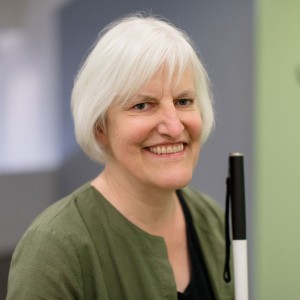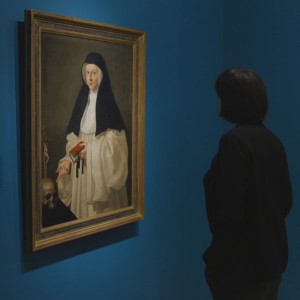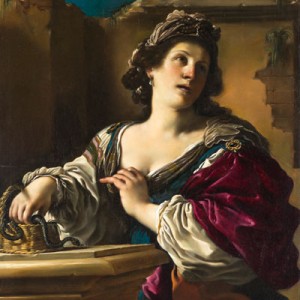Audio: Learning from the Body: A Conversation with Veronica Alvarez

Audio Series: Touching Art: Embodied Experiences in Museums
Featuring three distinguished speakers from the fields of literature and disability studies, anthropology and education, this series of conversations with Assistant Curator Maggie Bell focuses on how the body shapes engagement with works of art. Building on historical themes addressed in the exhibition The Expressive Body: Memory, Devotion, Desire (1400–1750), the series explores questions of sensory perception, empathy and self-reflection in present-day museum encounters.
Learning from the Body: A Conversation with Veronica Alvarez
Veronica Alvarez is the Wallis Annenberg Director of Community Arts Partnership, and Faculty in Critical Studies at the California Institute of the Arts. She has been an education consultant for major international institutions, and she currently serves on the American Alliance of Museums’s EdCom Board and is a member of the Policy Council for the California Alliance for Arts Education. In her work as an educator, historian and arts advocate, Alvarez has observed the power of being present with works of art as a means of understanding the past and connecting with the present.
Related conversations in the series:
- More than Meets the Eye with Georgina Kleege, Professor of English at UC Berkeley
- Museum of the Senses with David Howes, Co-director of the Centre for Sensory Studies at Concordia University, Montreal
Transcript:
Maggie Bell:
My name is Maggie Bell, and I’m an Assistant Curator at the Norton Simon Museum. My current exhibition, The Expressive Body: Memory, Devotion, Desire (1400-1750) explores the physical and emotional impact of representations of the human body, and the historical role of the 5 senses in experiencing works of art. This series of conversations with scholars in the fields of art education, literature and anthropology, brings these themes into the present by addressing the role of the body and the senses in engaging with art today.
Dr. Veronica Alvarez is the Wallis Annenberg Director of CalArts Community Arts Partnership, an award-winning co-curricular program with CalArts that offers free after-school and school-based arts education. As a historian, educator and advocate, Veronica has extensive museum experience, having worked in leadership positions in major Los Angeles institutions including the Los Angeles County Museum of Art and the Getty Museum. Among her many public-facing roles, Veronica serves on the Policy Council for the California Alliance for Arts Education. Her expertise as an arts education consultant is sought internationally.
Veronica, I’ve so admired your scholarly yet very human approach to arts education research and practice. I’m delighted to speak with you today about the role of the body in understanding works of art, and challenges and profound successes that can come from considering both represented bodies and the physical experiences of learners in a museum setting. Welcome Veronica!
Veronica Alvarez:
Thank you. I’m so excited to be here.
Maggie:
So I want to start with a question that's maybe very basic or maybe not basic at all, which is, what draws you to museums?
Veronica:
I think so many things draw me to museums. And I think it depends on, we have multiple identities, right? So myself as a historian, I think the works of art are so amazing to be in front of so we could learn so much at about the person that made it, the culture that it was produced from, or an idea that the artist wanted to communicate. As a parent, when I take my son to the museum, I want to see it as a learning opportunity and I want him to enjoy the visit and engage with the works of art differently than I think if I was in my historian mode. And as a friend, when I take friends to museums, I love to talk about the works of art that draw me, and then also listen to what is interesting to them. And then as an educator, I love to share and engage with our different audiences and talk about how the works of art have changed and how they're currently experiencing these amazing objects.
Maggie:
That's such an excellent point, in terms of who we become as art appreciators or educators. There's so many factors that go into our relationship with works of art. I wanted to ask you a little bit about your work in engaging first-time visitors and how you've been doing that. What is important to you about someone visiting a museum, maybe someone who's never visited before?
Veronica:
Right. Yeah, because like I said, we have different identities. Sometimes I go to museums, as I was able to go see your amazing exhibition at the Norton Simon. And I love the Norton Simon, it's one of my favorite museums in LA. So as a visitor and then as an educator. And so I think as an educator I didn't grow up going to museums. It was a very unique experience. I didn't know I was allowed to go into museums. So as you mentioned, first-time visitors were very much at the forefront of my mind often. And then as an educator I very much believe in situated learning theory, which means that the environment a learner is impacts their learning. And so museums can be intimidating for first time visitors, or they could be a lot of fun. And so I like to break down those barriers, because I was formally a classroom teacher.
Veronica:
And in terms of learning, there was a lot of rules, a lot of mandates that were enforced by the principal, by the state. But in a museum you could break down those barriers. And I found that being with objects, you can use all your senses to learn. And for me growing up, I was an immigrant, English wasn't my first language. And so all of these unknown rules about going to museums, you had to be quiet, you're not allowed to touch obviously. And my very first trip to a museum, I remember I went with my school and the teacher's like, "You have to dress formally, you have to wear tights." And it was my first time ever buying my, coming, running home and telling my mom, "They want us to wear tights to this field trip."
And so like I said, there was these rules that were kind of communicated, kind of not. And you're just supposed to know that you're supposed to, like I said, be quiet in a museum or not touch, don't run. And then when you go, that's often the first thing you hear, you're hearing these, reinforce these rules. Like don't, don't, don't. And so that could be off-putting and intimidating.
Maggie:
That's so interesting about the implicit rules of walking into a museum. What can educators do to make a museum a more welcoming place?
Veronica:
One is to, instead of the "Don't, don't, don't," encourage them and talk about the possibilities that are available there. I was a classroom teacher, and when I went to be an educator in a museum, so I was like, "You don't have to grade or have parent teacher conferences? This is awesome." You could still teach and engage and listen and have discussions with works of art without all of these other barriers in mind.
And then being specifically in front of a work of art. It was very different than when you see it in a book or in an image. You could walk around a sculpture. You could, without getting too close, but look closely. I was just in your museum and then the van Gogh and the mulberry tree, and seeing how thick the paint is applied. You can't get that just from an image. So there's something really powerful that I think physically happens to us when we're in front of a work of art.
Maggie:
I totally agree. So I want to talk about representations of the body and approaches to teaching images of the body. I know you've been thinking through especially representations of women's bodies similar to the works of art that I'm talking about in expressive body. So I would be curious to know your thoughts on how images of the nude or how images of women have been presented in more traditional Western works of art, and what are some challenges in teaching this material?
Veronica:
I recall working at the Getty Villa. The Getty Villa only has ancient Greek, Roman, and a little bit of Etruscan art. And a lot of it was the nude body, because the Greeks and the Romans saw that as an ideal, an ideal form. And I recall getting requests from visitors or teachers like, "We're going to take our kids, but please make sure they don't see any nudity." That's going to be kind of impossible unless you want to put blinders on. So depending on the age of the audience, we were very careful, but we talked about that actually there is no shame in nudity.
But then also there's the idea of how women have been depicted. There's a painting that I used to teach often with at the Getty Center, it was Venus and Adonis by the artist Titian. And the painting is like her backside and her holding onto Adonis as he's going to go leave to hunt. And she's a goddess so she knows that ultimately he's going to die in that hunt. So she's really holding him down. So you don't really see just the side of her profile or her face, but most of her backside. And the story that was often told or heard was that that was what they wanted because Philip II, who was a huge patron of Titian, didn't have an image of the backside of a woman.
So that is why Titian decided on that kind of composition. Like, they had a frontal nude of a woman, but hey, we want the backside as well. And it's always with this idea of the male gaze on women.
Maggie:
That's such an interesting point about the artistic motivations for depicting nude women. And this gets to other conversations we've had about representations of sexual violence. And I know this is something that you've thought a lot about. And I think of representations of the abduction of the Sabines, sometimes known as the rape of the Sabine women, which, in the expressive body exhibition we have a bronze by Giambologna that is just this beautiful representation of a very violent episode, with the justification at the time that it was such a great artistic challenge to represent something like this. So how do you reconcile this supposed artistic endeavor to represent these scenes with the reality that they're very violent.
Veronica:
I think that that has shifted a lot in terms of my career in museum education. As you mentioned, we talked about the abduction of Europa or the abduction of the Sabine women and now there's more forceful language to depict about the rape of Europa. And again, because I work with visitors of all ages, I try to be age appropriate. But with an adult audience, I feel that museums can and should be much more transparent about what these objects are actually depicting, about who's commissioning these works, about how they would have been seen in the historical context.
Because as you know, a lot of these objects were not meant to be put in a museum. A lot of them were in people's homes, in their cabinet of curiosities, or in the place where only men would be able to gaze at them, or in churches or in other different formats. And then now that they're in a museum setting with general visitors, what is the museum's responsibility in how we are talking about this, how we're choosing to display them, how we're choosing to talk about them in the labels, in the catalogs, in the exhibitions? Because all of that is adding to the art historical knowledge.
Maggie:
I want to think a little bit about, as we started this conversation, what viewers bring to an experience of a work of art, be it historical knowledge or perhaps personal experiences, even trauma. And as an educator, how can we reconcile this? How can we deal with these very sensitive, potentially very sensitive encounters that people can have?
Veronica:
Oh, that's such a good question. I think as an educator I believe in constructivism, which is that people learn based on their personal knowledge and experience, and everybody has a lived experience that they bring into any encounter. And I actually always approach engaging with audiences to see, to listen, by starting by listening to what is interesting to them. So sometimes it could be the biography of the artist, or sometimes it could be about the materiality of the object.
But if we are going to discuss these important issues, it would be important to have some kind of trigger warning and being up front, again, that being transparent. Like, in this tour or in this experience we're going to be looking at objects that depict violence or that depict the female figure in problematic ways. And we're going to discuss those or talk about that. So that way, and that's what I love, I said change from classroom to the museum experience is usually a self-directed, and people self-select to do this, and they're not obligated to be there.
Maggie:
That's such a nice point, because it goes back to what you said about the imposition of the museum as this singular authority and the way that through education it's possible to challenge that in really meaningful ways.
I wanted to ask you about a response to a work of art, maybe a bodily physical response to a work of art that you've had that has illuminated its meaning for you in a particular way.
Veronica:
I was thinking about this question a lot. Because like I said, it's been so different in different contexts. And the one that really stood out to me I think was when I was at MASS MoCA and I went to an exhibition by Nick Cave, he's a contemporary artist, and he is really known for his sound suits. So they're these, he uses recycled objects to create these suits that people could put on and sometimes walk around in, and they make all of these amazing sounds.
They're very sensory. You could hear them, you could see them, you could see the light glinting off of them as they walk around. But at MASS MoCA the exhibition was called Until, and it was almost like walking into the sound suit. Because it was just this, it's a huge space, it's like a football field. And I looked it up, it says he used 16,000 wind spinners, millions of plastic beads, thousands of ceramic birds, fruits, gilded pigs, 10 miles of crystals, 24 chandeliers. So it's just this massive, and it's so immersive, you're walking in, you're seeing, you're hearing the chandeliers, the crystals clinking against each other.
But then as you walk through you come abruptly into this images of guns and bullets and targets. And the exhibition was called Until, and it's a play on the phrase of innocent until proven guilty. But he tries to subvert that and says guilty until proven innocent, because he is talking about black violence or violence against black bodies and systemic racism in this culture. And so it was a jarring experience, because like I said, you're in the beauty of and hearing and seeing all of these beautiful objects, but then you start looking at details, and he uses items that were inherently racist and subverts that.
Maggie:
That's such a brilliant example, because it seems that without the bodily experience, without the multisensory experience, the core meaning of that installation would be lost.
Veronica:
I wanted to say, one thing that I loved about your exhibition was the image of Christ that you included. Because when we talk about, like I said, constructivism, people use their lived experiences and engage with the works of art differently. Each individual person engages differently because of their lived experiences. So when I saw your head of Christ, it brought me back to my childhood. Because I was born in Mexico, and in Catholic culture images, we talked about the images that are supposed to be in churches, they're very important for us in so many different ways, because we are physically supposed to respond to Christ's suffering. And so as I mentioned, you brought me back to my childhood because we had to make a pilgrimage, it's called La Virgen de San Juan de los Lagos, near the state where I was born. And supposedly she had performed a miracle, the statue had performed a miracle. She had brought this young girl to life.
So as part of our Catholic upbringing we're supposed to go and venerate this statue, and just being in its presence is supposed to be an amazing experience. But I remember as a young girl, women, to show our devotion or to show ... And it was all women and I didn't even think of it then, but they were crawling basically on their knees as they were saying the rosary as they're approaching the statue. And I remember asking my mom why some of them have bloody knees as they were going to the statue. So this idea of the physical body and what it does when they're looking at a work of art. And that statue is still in this church. But I couldn't help but thinking in preparing for this conversation, what if we removed that statue and put it in a museum?
And that's, like I said, an interesting experience I had with seeing your Christ, because again, the suffering of Christ is, you're supposed to feel his suffering so that you could show your devotion, so that you could prove how devout you are. It was an interesting experience that brought my childhood, and again, that's why it's so amazing to go to museums. Because it brought these memories that I hadn't had, because I'm no longer a practicing Catholic, but I was like, "Oh yeah, the importance of what objects mean to a culture, to a society is still so relevant today."
Maggie:
I'm so glad you brought up that part of the exhibition. And I thought a lot about this, where it's really such a sterile environment for most of these objects, because they were specifically Catholic objects and would have been seen in these really rich multisensory environments. And that's all lost in a museum, and I don't have a good answer for that as a curator yet in terms of how to really create the richness of that original experience.
Veronica:
The Getty has a St. Gines de la Jara, it's a statue from Spain, and I did, and as an educator, I did try to create that as much as I could. Like you said, it's impossible unless we're putting the statues back in a church. But I was like, "Oh, imagine," and again, that's what we could say museums are different learning environments, say, than a classroom space. But I could say, "Imagine this statue," because it was gilded, a lot of these statues are gilded. They would have very realistic materials, glass eyes. So I would say, "Imagine, this would have been surrounded by candles." Because it was done in the 1600s, so we didn't have electricity.
So the candles would have been glinting from his robes and the gilding would've reflected. And like I said, as a Catholic person growing up I would have been like, these statues almost coming alive with these glass eyes and the glinting of the robe. And it almost would seem like he was moving and so forth. So yeah, we can't recreate it, but we could talk about the context that they would have been in and how that might have either impacted the viewer or was meant to impact the viewer in the 17th century and how that changes for us now.
Maggie:
Thank you for sharing your personal experience. It really made this conversation so meaningful, and that's my hope with the exhibition, is that we can all have some version of whatever we bring of ourselves to it.
This kind of resonance. So thank you so much.
Veronica:
My pleasure. Thank you so much for inviting me and to talk about objects, themes that I think are so important to address.
Maggie:
This conversation is part of the series, Touching Art: Embodied Experiences in Museums, produced in conjunction with the Norton Simon Museum’s exhibition The Expressive Body: Memory, Devotion, Desire (1400–1750), on view October 15th, 2021 through March 7th, 2022.
Additional conversations with Georgina Kleege, Professor of English at UC Berkeley, and David Howes, Co-director of the Centre for Sensory Studies at Concordia University, Montreal, are available at






